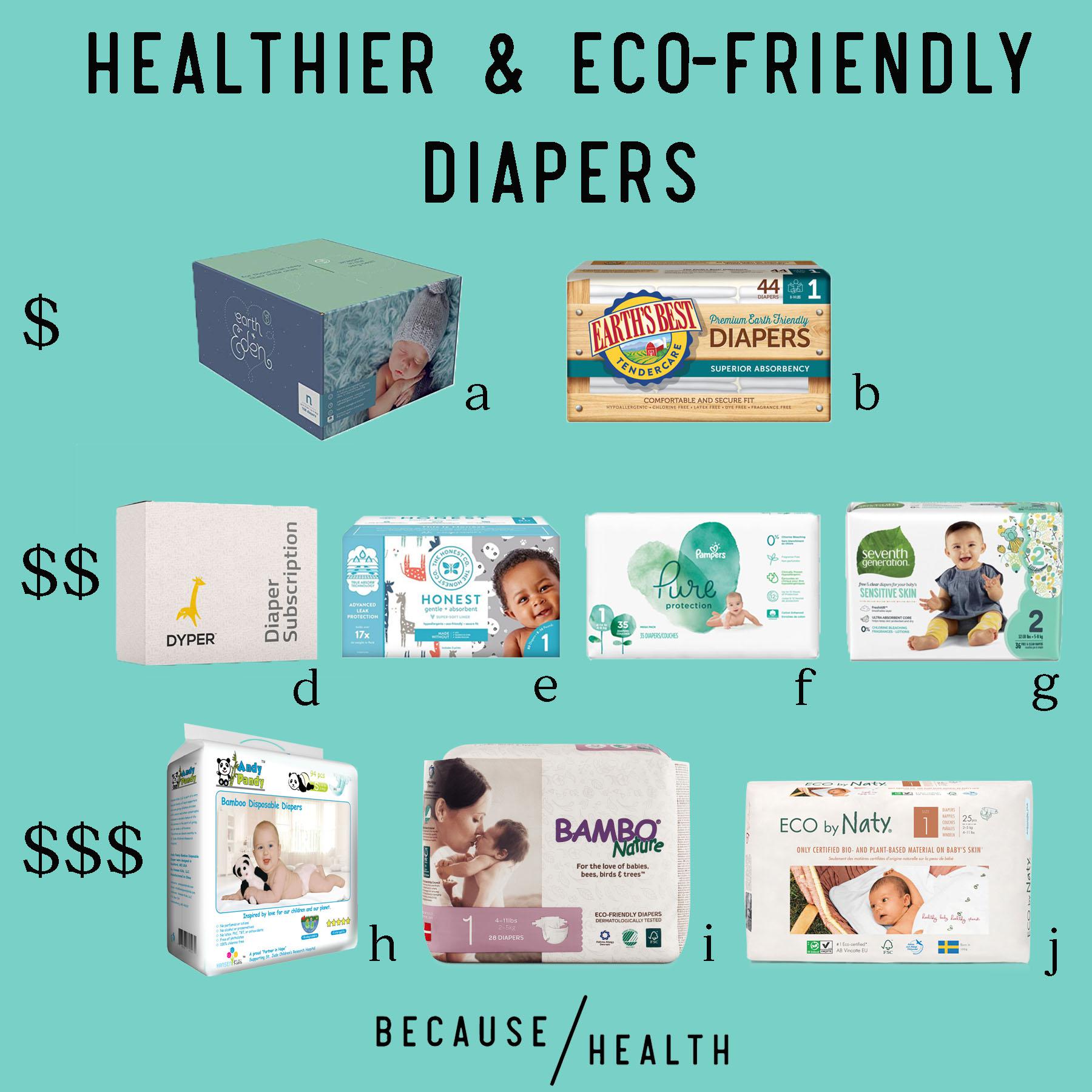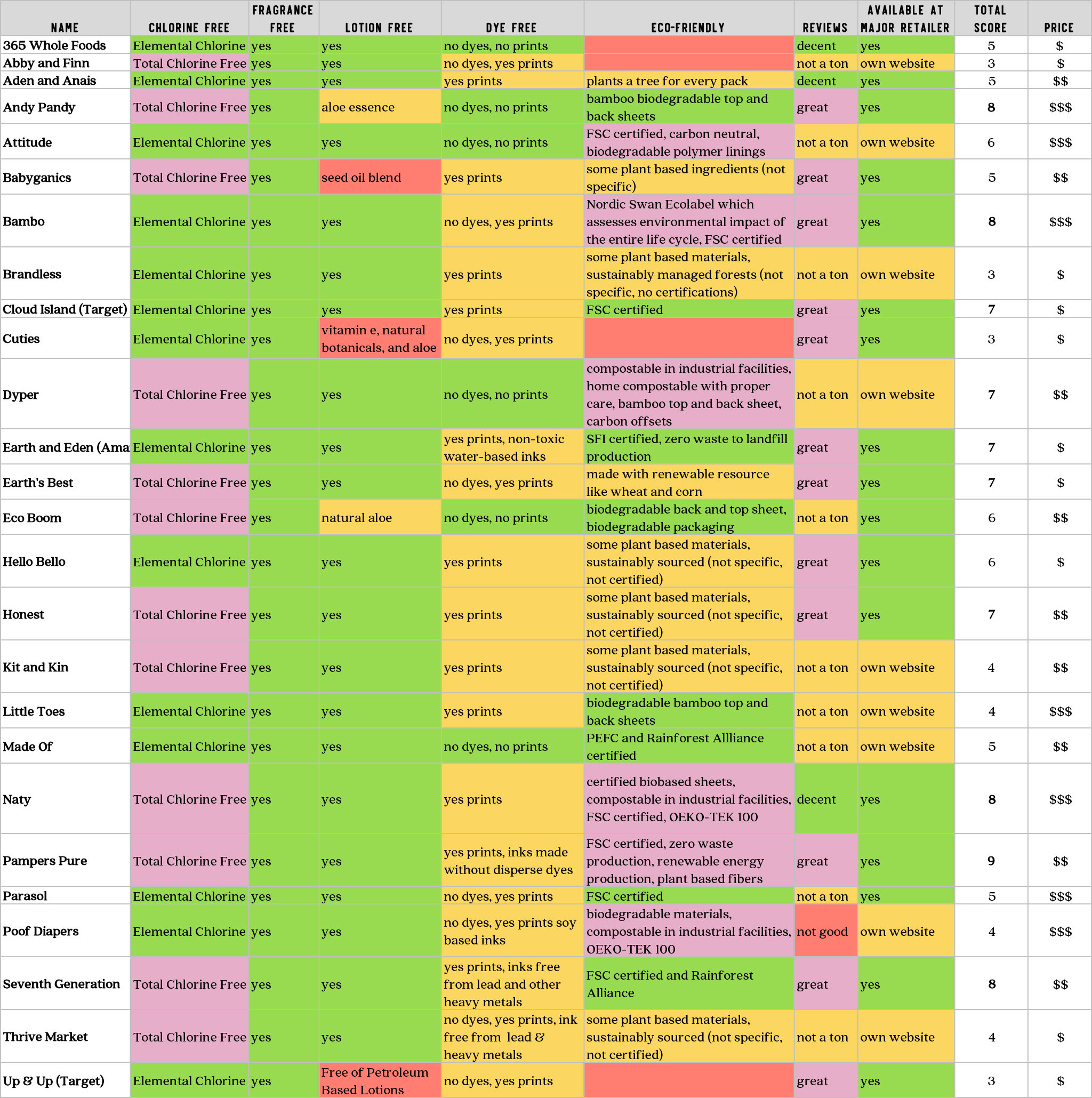The 10 Best Healthier & Eco-Friendly Disposable Diapers
Our picks that is good for your baby and the planet
Cloth diapering just not for you? No judgement here! When it comes to disposable diapers, we know that all parents want the best for their baby, but are often overwhelmed by the choices and all the healthy and environmental claims that companies make. We evaluated 26 diapers that claim to be non-toxic, green, or natural. We looked at whether they were free of harmful and irritating ingredients and assessed truth of their eco-friendly claims. We then developed a score for each diaper and found 10 great options in every budget.
Here is a run down of the criteria we evaluated for each brand:
Chlorine-Free
Chlorine and its derivatives (such as chlorine dioxide) are used to bleach and process wood pulp. However, there is a difference between elemental chlorine free (ECF) and total chlorine free (TCF). Even though all brands we evaluated claimed to be chlorine-free, most of them are actually only elemental chlorine free, meaning they still use chlorine derivatives like chlorine dioxide. Brands that are totally chlorine free use altogether different chemicals, like hydrogen peroxide, and processes. TCF is preferable to ECF because chlorine derivative still produce toxic chlorinated organic compounds that are released into waterways, where they produce environmental damage.
Fragrance Free
Not only are fragrances unnecessary in diapers, fragrances can contain allergens and irritants and endocrine disrupting chemicals such as phthalates. All of the brands we evaluated are fragrance free.
Lotion Free
Lotions are also unnecessary in diapers. Many lotions are petroleum-based and even natural botanical based ones can also irritate the skin. If our babies have a rash or dry skin, we prefer to put on a non-toxic lotion that we pick out ourselves onto the affected skin.
Dye Free
This is a complicated one. Those cute patterns or colored bands are from dyes and pigments that can cause skin rashes. But as the folks at BabyGearLab explain, not all manufacturers use the same definition of “dye free” because many diapers that obviously have prints and colors also claim to be dye free. Some companies will say they are dye-free, but then say they use pigments or inks and might make claims about the safety of those pigments/inks. Sound confusing? It is. It’s unclear what is really going on here, so if your baby has particularly sensitive skin, stick to diapers that say dye free and also don’t have any prints or patterns.
Eco-Friendly
There are a lot of terms thrown around by brands such as biodegradable, compostable, plant-based, sustainable sourced pulp etc… Let’s take a look at each of these terms.
Plant-based: In traditional diapers, the cloth-like outer shell and inner lining are usually made from a synthetic plastic material. When companies say that they use plant based materials for the top or bottom sheet, they could mean that they use something like bamboo, cotton, or a plant based plastic.
Biodegradable: Some brands will then say that they are biodegradable (or partially biodegradable) because these plant-based materials could break down under right circumstances. Unfortunately, in the anaerobic (oxygen-free) environments of landfills, where most diapers end up, these diapers are unlikely to degrade. It is nice that some of the materials are not petroleum-based, as petroleum extraction and processing is so harmful to humans and the environment. Of course we like to see brands who are innovating with new materials, but the biodegradable claim might be going too far.
Compostable: Only one brand has said that it can be home composted with proper care, and other compostable diapers must be composted in an industrial facility, which are not available in most areas. Check out if there is a local composting facility near you. If there isn’t, buying a compostable diaper and then throwing it in the landfill is not going to do much of anything as they won’t degrade in the landfill.
Sustainably Sourced Pulp: The fluffy paper pulp in the middle layer of diapers comes from trees. It could result in deforestation, decreased biodiversity, land and water degradation, and climate change impacts. Brands that source their pulp from suppliers that have been verified by a credible certification program for sustainable forestry practices like the Forest Stewardship Council (FSC) are preferred. FSC is an international non-profit that sets standards on forest products, to ensure that products come from responsibly managed forests that provide environmental, social and economic benefits.
Other: Brands can go above and beyond by doing things like purchasing carbon offsets, using renewable energy in their production, limiting waste in their production facilities, or seeking more intense environmental certifications.
Reviews
Of course babies comes in all shapes and sizes, so there are always going to be some diapers that have great reviews that just don’t work for some babies. We looked at the star ratings and number of reviews from customers available at a variety of online stores to assess a general consensus for each brand. There are always going to be bad reviews on products but we try to look at the overall picture.
Availability
As always, we prefer to brands that are available at one or more major retailers, because it’s convenient to buy diapers and other household and personal care products where you do your other shopping. There are lots of brands which you can only buy on their own website, or through a monthly subscription.
Top 10 Healthier and Eco-Friendly Diapers
Based on these criteria, we formed a score (see below for a table on all diapers evaluated and their scores) and came up with our picks for healthier and eco-friendly diapers and we categorized them based on pricing so that there are options for every budget.

$ a) Earth & Eden (Amazon) b) Earth’s Best
$d) Dyper e) Honest Company f) Pamper’s Pure g) Seventh Generation
$ h) Andy Pandy i) Bambo Nature j) Eco by Naty
Scoring Details and All Brands Evaluated
The way we scored each brand was to evaluate them based on each of these criteria. In the table below, purple is worth 2 points, green is 1 point, yellow is 0 points, and red is -1 points. We then picked the top 10 scores and categorized them based on pricing for size 1 diapers. Use this chart to find out more about the 26 brands we evaluated and our top 10 picks.

Because Health is a participant in the Amazon Services LLC Associates Program, an affiliate advertising program so that when you click through our Amazon links, a percentage of the proceeds from your purchases will go to Because Health. We encourage you to shop locally, but if you do buy online buying through our links will help us continue the critical environmental health education work we do. Our participation does not influence our product recommendations.
